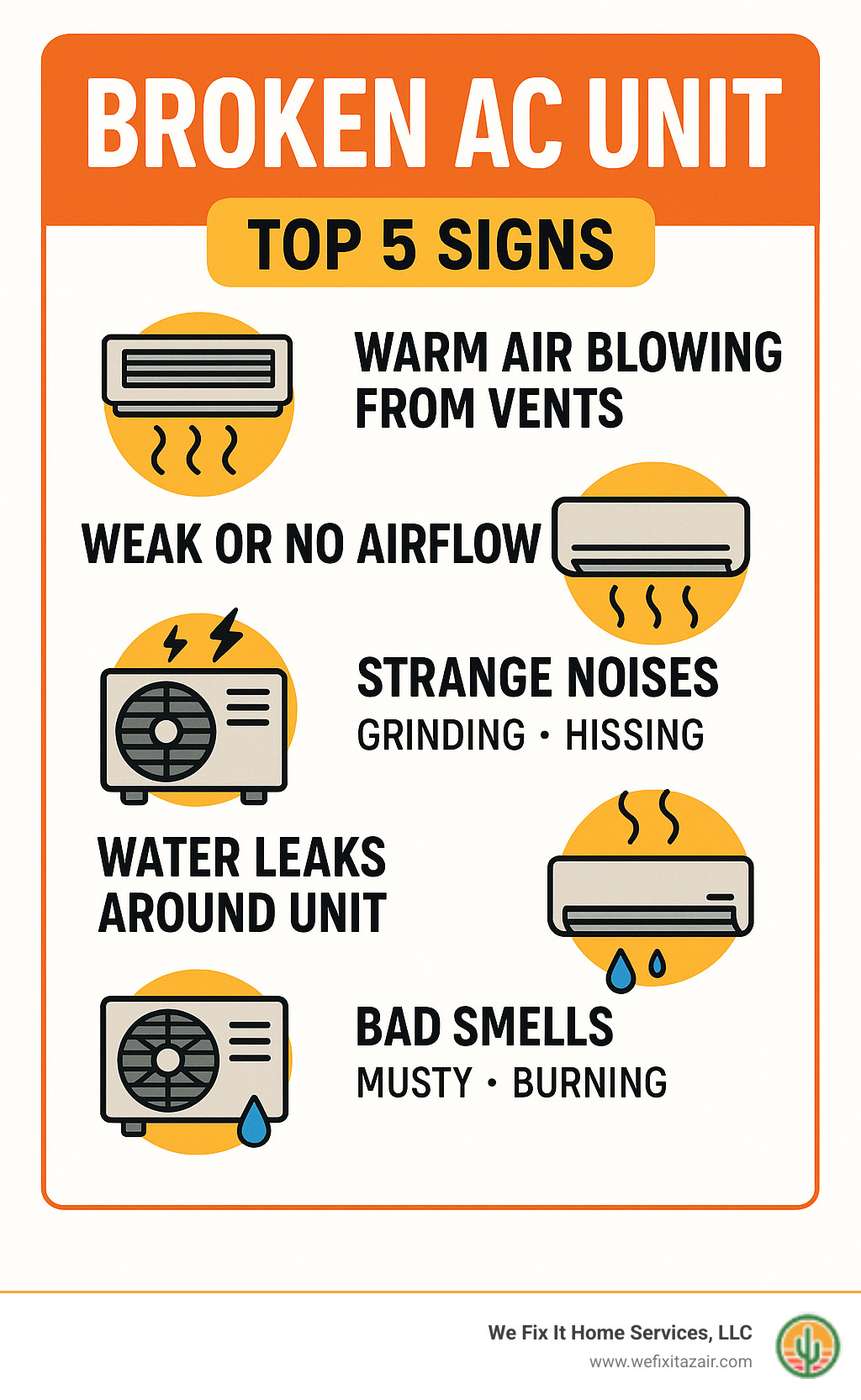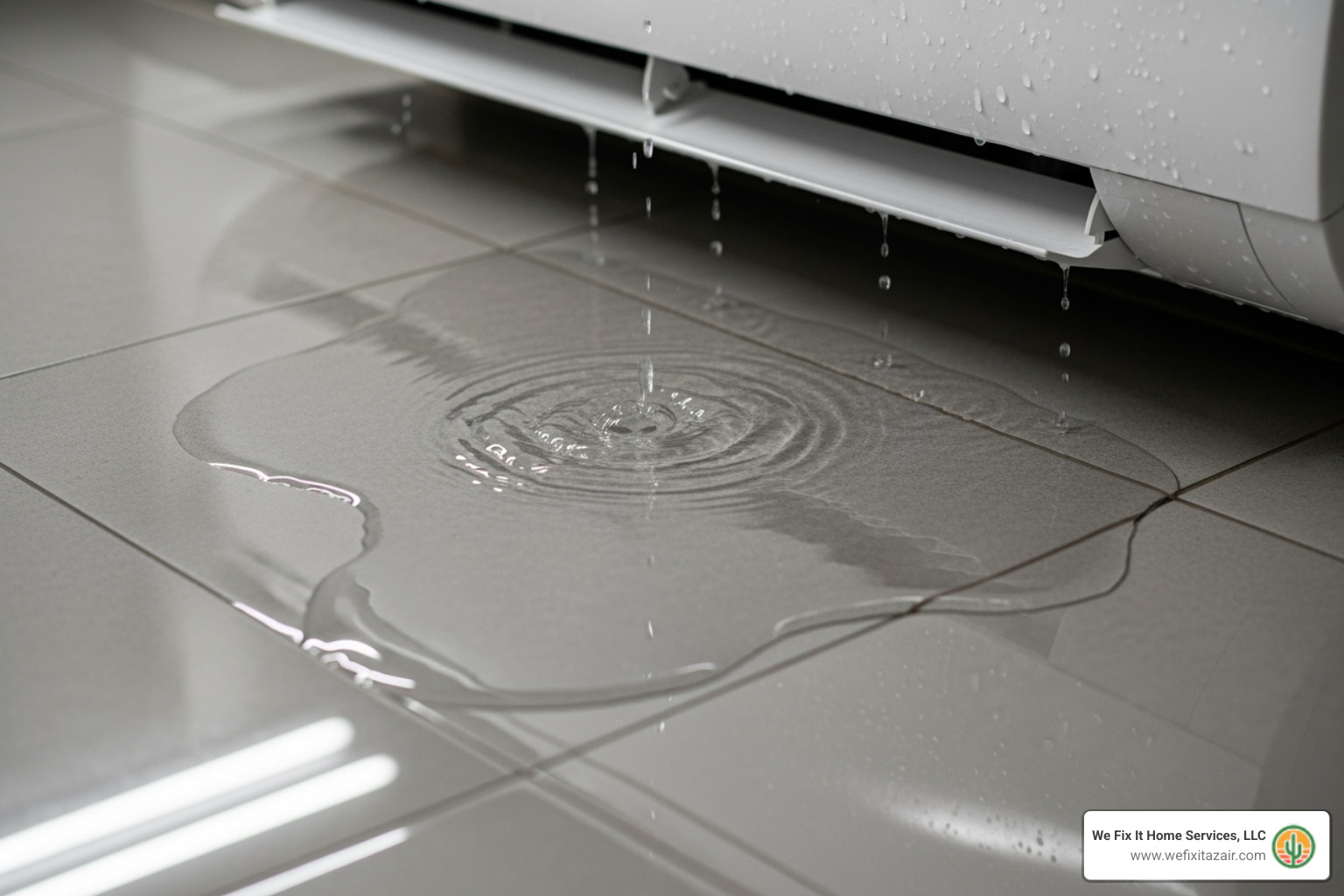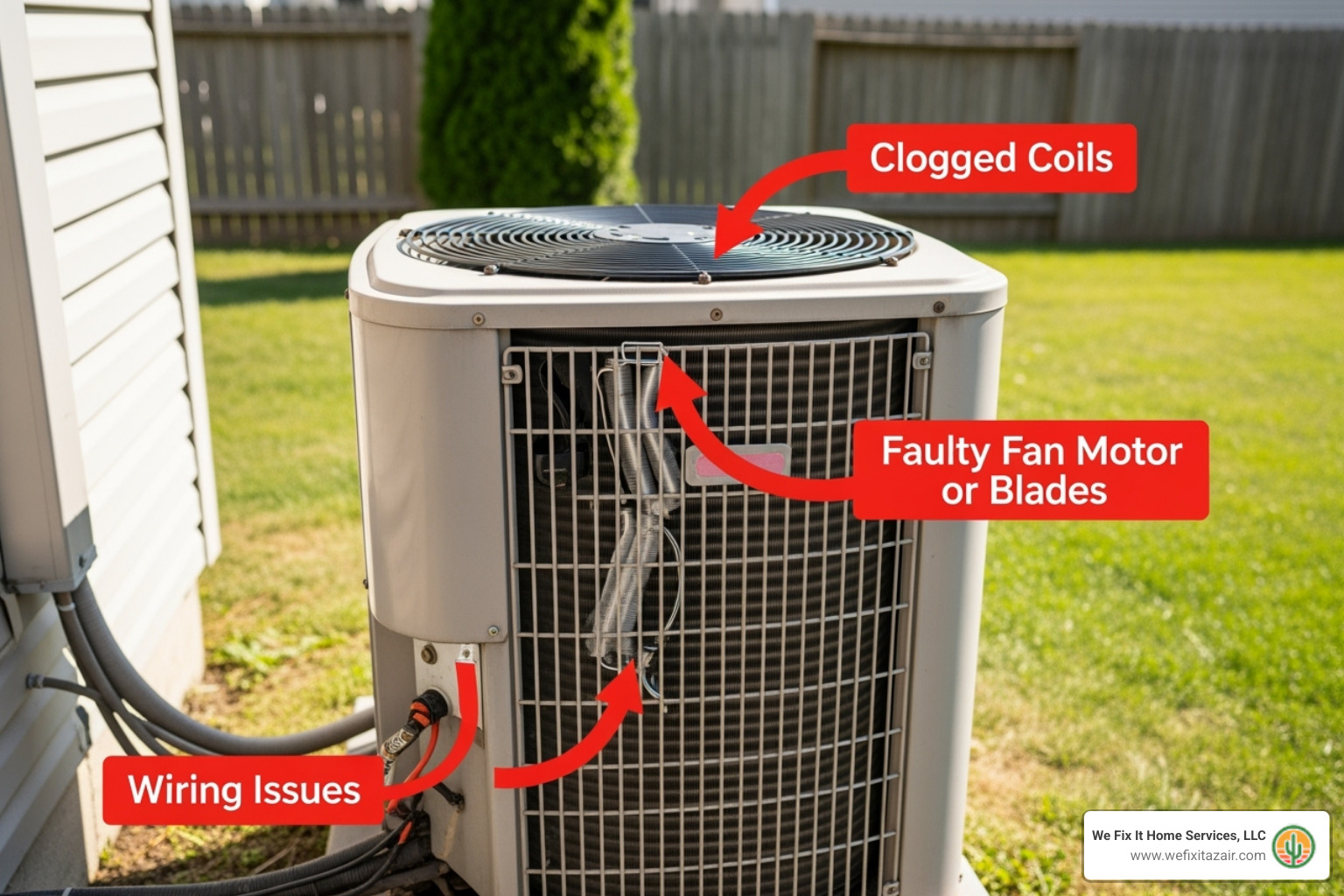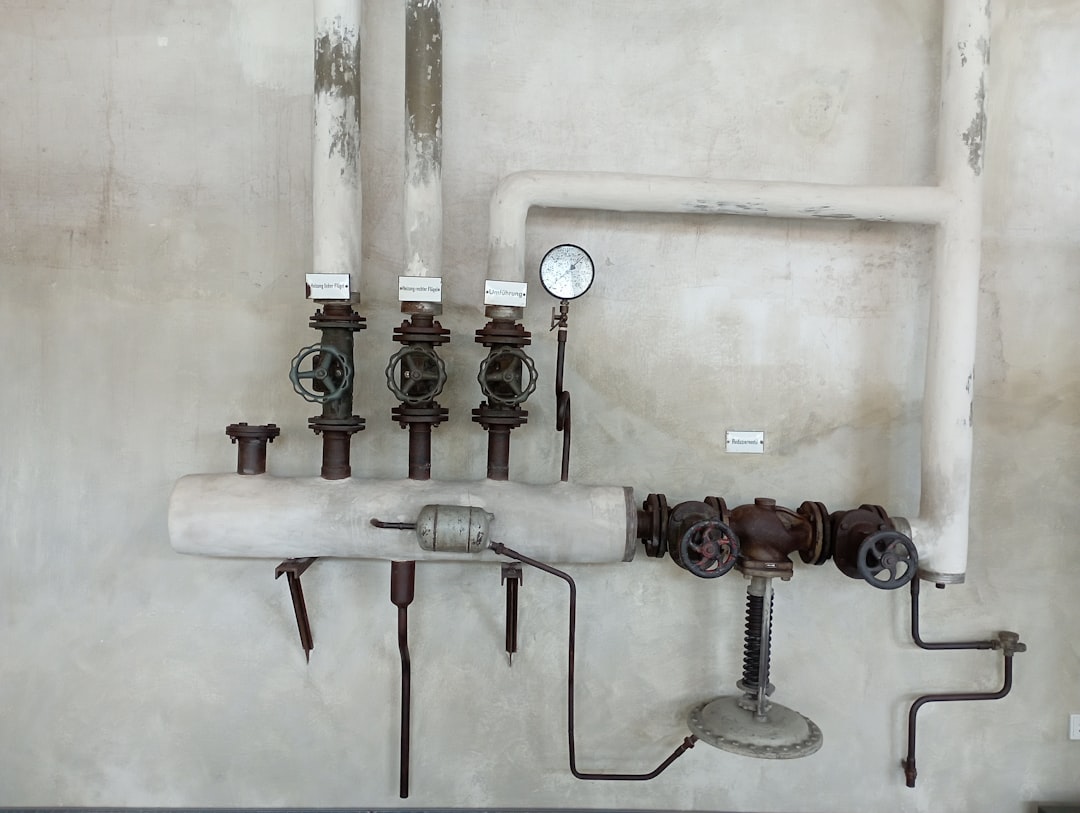Broken AC Blues: Get Your Cool Back with These Fixes

When Your AC Fails in Arizona's Extreme Heat
A broken AC unit can quickly turn your Arizona home into a furnace, especially when temperatures soar above 100°F. Whether your system is blowing warm air, making strange noises, or completely shut down, you need answers fast.
Quick troubleshooting steps for a broken AC:
- Check your thermostat - Ensure it's set to "cool" and below room temperature
- Inspect the circuit breaker - Look for tripped breakers and reset if needed
- Examine the air filter - Replace if dirty or clogged
- Clear debris around the outdoor unit for proper airflow
- Listen for unusual sounds - Hissing, banging, or grinding indicate specific problems
Nearly every Arizona homeowner has experienced their air conditioner failing on a scorching summer day. AC systems are more prone to breakdowns during summer because they're working nonstop to combat the relentless heat.
The good news is that many common AC problems have simple solutions you can try before calling a professional. Understanding what's wrong with your system can save you time and discomfort. However, some problems require immediate professional attention—especially refrigerant leaks, electrical issues, or compressor failures that can cause expensive damage if ignored.

Terms related to Broken AC unit:
Signs Your Air Conditioner is Broken
When your Arizona home starts feeling more like an oven, your AC is trying to get your attention. Recognizing the warning signs of a broken AC unit can help you avoid a complete system breakdown in the middle of a 115-degree day.
- Warm air blowing from your vents is a major red flag, often stemming from low refrigerant, a dirty filter, or condenser issues.
- Weak airflow where air barely trickles out of vents usually points to ductwork blockages, a dirty coil, or a struggling blower motor.
- Frequent cycling, where the system constantly turns on and off, can result from a clogged filter, an oversized unit, or low refrigerant.
- High humidity that leaves your home feeling sticky despite the AC running often signals refrigerant problems or an improperly sized system.
- Water leaks around your indoor unit usually mean your condensate drain line is clogged.
- Bad odors or strange noises from your system deserve immediate attention.

Identifying Strange Noises and Smells
Your broken AC unit often communicates through sounds and smells. Learning to decode these signals can help you understand what's happening.
- Banging or rattling sounds usually mean something's come loose, like a fan blade or a more serious compressor motor issue.
- Hissing sounds likely indicate refrigerant escaping through a leak, which requires professional attention.
- Screeching or squealing noises often point to worn fan belts or motor bearings that can lead to motor failure.
- Musty or moldy odors suggest mold or mildew has grown in your unit or ductwork due to trapped moisture.
- Burning or electrical smells demand immediate action. Turn off your system right away, as this signals an overheating electrical component.
- A rotting smell usually means a small animal has gotten trapped in your ductwork and needs to be removed by a professional.
Visual Cues of a Problem
Sometimes your AC shows you what's wrong. Keep an eye out for these visual warning signs.
- Ice or frost on coils, whether on the indoor or outdoor unit, typically indicates airflow problems from a dirty filter or low refrigerant levels. You can inspect the inside of your cooling unit for frost or ice to check for this common issue.
- Water leaks or puddles around your indoor unit signal drainage problems, like a clogged condensate drain line.
- Visible damage to your outdoor unit, such as bent fins or debris buildup, can choke your system's performance.
- A tripped circuit breaker indicates your unit is drawing too much power, often due to an electrical fault or an overworked component.
Simple Troubleshooting Steps to Try First
When your broken AC unit leaves you sweating, don't panic. Many common air conditioning problems have simple solutions you can tackle yourself before calling a professional.

Here's our simple 5-step troubleshooting checklist before calling a pro:
- Check your thermostat - Is it set correctly?
- Inspect the circuit breaker - Has it tripped?
- Examine the air filter - Is it dirty and restricting airflow?
- Clear debris - Are there leaves or dirt around your outdoor unit?
- Listen and look - Any unusual sounds, smells, or visible ice or water?
These steps might seem simple, but they often solve the problem. Let's dive deeper into each one.
Check Your Thermostat
Your thermostat is the brain of your cooling system. What looks like a broken AC unit might just be a confused thermostat.
- Check the batteries. If your thermostat has a blank or dim display, it might just need fresh batteries.
- Verify the settings. Ensure your thermostat is set to "Cool" mode, not "Heat" or "Fan Only."
- Adjust the temperature. The temperature setting must be a few degrees below the current room temperature for the AC to turn on.
- Restart smart thermostats. If you have a smart thermostat, a simple restart can sometimes clear up connection or software glitches.
Inspect the Circuit Breaker and Power
No electricity means no cool air. If your AC suddenly stops working, check the power supply.
- Look for a tripped breaker. Head to your electrical panel and find the breaker for your AC. If it's in the "off" or middle position, flip it completely off, then back on. Wait about 15 minutes before restarting your AC to prevent damage.
- Check for a blown fuse. Older systems may have a fuse that needs to be replaced entirely.
- Verify the outdoor disconnect switch. Many outdoor units have a separate power switch nearby. Make sure it's in the "on" position.
Examine the Air Filter
A dirty, clogged air filter is a common culprit behind a seemingly broken AC unit. It restricts airflow, forcing your system to work much harder.
This restricted airflow can lead to warm air from vents, constant running without cooling, and even a frozen evaporator coil. The good news is that changing an air filter is an easy and essential maintenance task.
For your filter replacement schedule, we recommend changing it every one to three months. However, during Arizona's intense summers or if you have pets, monthly changes are a good idea.
How to change a filter: Most filters are in the return air vent or inside the air handler. Slide the old one out and slide the new one in, ensuring the arrows on the filter frame point in the direction of airflow.
Common Causes of a Broken AC Unit
Even well-maintained AC systems can develop problems. Understanding what typically goes wrong with a broken AC unit helps you recognize issues early and know when to call for help. Arizona's extreme heat puts extra stress on every component, leading to common breakdowns.

A Dirty Air Filter or Clogged Coils
Inadequate maintenance is a top reason AC units fail. A clogged air filter leads to reduced airflow, forcing your system to work harder, increasing energy bills and reducing comfort.
A serious consequence is a frozen evaporator coil. When air can't flow properly over the indoor coil, it gets too cold and freezes, preventing it from absorbing heat. You might notice water dripping from your indoor unit as the ice melts. Inspect the inside of your cooling unit for frost or ice to check for this problem.
Your outdoor condenser coils can also get dirty from dust and debris. When these coils can't release heat, your system overheats, which can lead to expensive repairs or complete failure in Arizona's heat.
Refrigerant Leaks and Your Broken AC Unit
Refrigerant is the lifeblood of your AC, absorbing heat from inside your home and releasing it outside. It operates in a closed system, so if levels are low, you have a leak. For a straightforward overview of how this process works, see the vapor-compression refrigeration cycle.
When there's not enough refrigerant, your AC can't cool properly and will blow warm air. You might hear hissing sounds as the refrigerant escapes. Beyond ineffective cooling, these leaks have environmental concerns.
Running an AC with low refrigerant puts your compressor at risk. The compressor damage risk is high because it works overtime to compensate, which can destroy this expensive component and lead to a full system replacement.
Electrical Control and Component Failure
AC systems rely on many electrical components. When one fails, the whole system can shut down.
- Faulty capacitors are common. They provide the power surge to start motors. A bad capacitor might cause a clicking sound as the system tries and fails to start.
- A worn contactor acts as a switch for major components. If it burns out, power won't reach the compressor or fan motor.
- Corroded wires, especially in outdoor units, can cause intermittent problems.
- Blower motor issues affect the indoor fan. If it fails, you'll feel little to no airflow from your vents.
- Compressor problems are the most serious. The compressor is your AC's engine, and its failure often results from other issues being ignored.
Drainage Problems
Your AC removes humidity from the air, creating condensation that drains away through a condensate drain line. Over time, this line can become clogged with algae and debris.
When a clogged drain line causes water backup, the drain pan can overflow, leading to water damage. Many systems have a safety switch that shuts off the AC to prevent this. The stagnant water can also lead to mold and mildew growth, creating musty odors and affecting air quality.
When to Call a Professional for AC Repair
While some fixes are simple, there comes a point when your broken AC unit needs a professional. AC units contain high-voltage electricity and pressurized refrigerants, making some repairs dangerous for homeowners.
Safety should always be your top priority. One wrong move could result in injury or chemical exposure. Attempting fixes beyond your skill level can turn a simple repair into a costly disaster.
Complex repairs like compressor failure or major electrical faults require specialized knowledge and diagnostic equipment. Our NATE-certified technicians use precision tools to accurately diagnose problems that most homeowners can't.
Furthermore, handling refrigerant is illegal for unlicensed individuals. It is a chemical that requires proper certification to handle and dispose of. Electrical work within your AC system is also best left to professionals due to the high-voltage components.
If you've tried basic troubleshooting and the problem persists, it's time to call for help. Persistent issues often indicate underlying problems that require professional diagnosis.
Signs You Need an Expert for Your Broken AC Unit
Some situations demand an immediate professional call. Here are the red flags:
- Refrigerant leak suspected – If you hear hissing, see ice on the coils, or get only warm air, call an expert. Running your system with low refrigerant can cause expensive compressor damage.
- Electrical burning smell – This is an emergency. Turn off your unit at the thermostat and circuit breaker, then call us immediately. It could indicate a fire risk.
- Loud banging or grinding noises – These aggressive sounds often signal major mechanical failures in the compressor or fan motor that require immediate attention.
- AC won't turn on after basic troubleshooting – If you've checked the thermostat, breaker, and filter, and the unit is still dead, it likely points to a deeper electrical issue or component failure.
How to Prevent Future AC Breakdowns
Nobody wants to deal with a broken AC unit during an Arizona summer. The good news is that most breakdowns are preventable with regular care and smart habits.
Regular maintenance is your best defense. Just like a car needs oil changes, your AC needs consistent care to perform its best. Catching small issues early prevents them from becoming expensive headaches.
Annual tune-ups are a worthwhile investment. During these visits, our NATE-certified technicians will clean coils, check refrigerant levels, inspect electrical connections, and lubricate moving parts to prevent costly breakdowns. A well-maintained system runs more efficiently, lowering energy bills and extending its lifespan.
Between professional visits, you can do your part. Keep your outdoor unit clear of leaves, grass, and debris that can block airflow. A gentle spray with a garden hose can remove built-up dirt, but be careful not to bend the delicate aluminum fins.
Inside, ensure unobstructed airflow by keeping furniture away from air vents and interior doors open to help air circulate freely.
Consider upgrading to a smart thermostat. These devices help prevent breakdowns by optimizing how your system runs and can even alert you to potential problems before they become serious. They take the guesswork out of efficient cooling, putting less strain on your AC.
Frequently Asked Questions about a Broken AC
When your air conditioner acts up in Arizona's heat, you'll have questions. Here are the most common concerns we hear from homeowners dealing with a broken AC unit.
Why is my AC unit blowing warm air?
This frustrating problem usually stems from one of three main culprits: a dirty air filter restricting airflow, low refrigerant levels due to a leak, or problems with your outdoor compressor, which is the heart of your cooling system.
What do different strange noises from my AC mean?
Strange sounds are your AC's way of telling you something is wrong. Here's a quick guide:
- Screeching often points to a fan belt or motor bearing issue.
- Banging can indicate a serious compressor problem or loose parts.
- Hissing is a classic sign of a refrigerant leak.
- Rattling or buzzing might indicate loose panels or debris.
- Repeated clicking when the system tries to start often means an electrical component is failing.
How do I know if my AC unit is the right size for my home?
An improperly sized AC unit is inefficient and prone to problems. The system's behavior is a key indicator.
An oversized unit will short cycle—turning on and off frequently. It cools the air too quickly to properly remove humidity, leaving your home feeling cold and clammy.
An undersized unit will run constantly on hot days without ever reaching the set temperature. This leads to high energy bills and uneven cooling.
Proper sizing requires a professional load calculation that considers your home's square footage, insulation, windows, and our unique Arizona climate.
Get Your Cool Back Today
Nobody should have to endure Arizona's blistering heat with a broken AC unit. We know how frustrating it is when your air conditioner fails when you need it most.
You're now equipped to handle simple fixes like checking the thermostat or changing a filter. But remember, some problems are best left to the professionals. Refrigerant leaks, electrical issues, and major component failures require the expertise and specialized tools of a trained technician. Calling for help is the smartest move to protect your investment and ensure your family's safety.
Proactive maintenance is your best friend in preventing future breakdowns. Regular tune-ups, clean filters, and keeping your outdoor unit clear can save you from emergency repair calls on scorching summer days.
At We Fix It Home Services, LLC, we understand that your comfort is our responsibility. Our family-owned business has been keeping homes cool across Pinal County and Maricopa County for years. Our NATE-certified technicians bring expertise and care to every service call, treating your home like our own.
Whether you need an emergency repair, routine maintenance, or advice on keeping your system running efficiently, we're here to help. Don't let a broken AC steal another moment of your comfort—reach out today and let us restore the cool, comfortable home you deserve.
Learn more about our HVAC services and find how we can help you beat the heat all summer long!




















Customer Testimonials

























